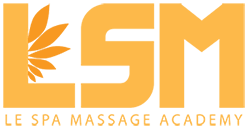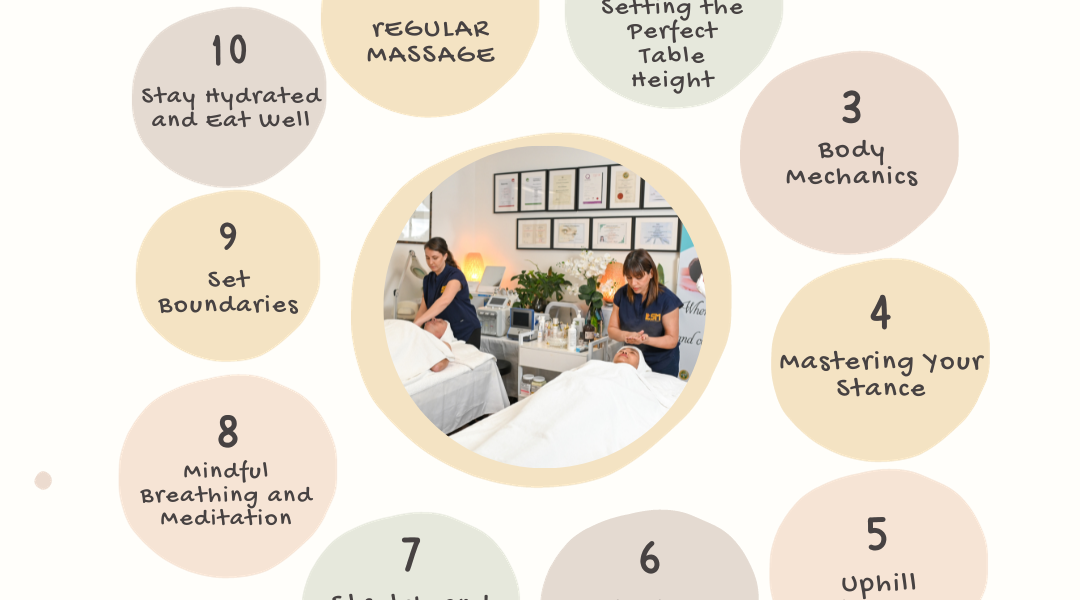Massage therapy is a rewarding and fulfilling profession that allows you to help others relax, heal, and find relief from physical and emotional stress. However, as a massage therapist, it’s crucial to remember that you must also prioritize self-care to ensure you can provide the best care to your clients while maintaining your own well-being. Here are ten self-care tips specifically tailored for massage therapists to help you stay healthy, energized, and focused in your practice. AND Let’s break down each of the self-care tips for massage therapists into actionable steps.
- Regular Massage
The first rule of self-care for massage therapists is to practice what you preach. Make it a priority to schedule regular massages for yourself. Not only will this help you relax and unwind, but it will also allow you to experience different techniques and gain insights that can benefit your own clients.
- Schedule Regular Appointments: Set up a recurring schedule for receiving massages. Aim for at least one session per month or as often as your personal preferences and budget allow.
- Explore Different Modalities: Experiment with various massage techniques and modalities during your sessions. This helps you gain firsthand experience of what your clients may feel and find what works best for you.
2. Setting the Perfect Table Height:
- Measure Your Knuckles to the Floor: Measuring the distance between your knuckles and the floor is crucial because it directly affects your body mechanics. An improperly adjusted table can lead to poor posture and unnecessary strain during massage sessions.
- Half of Your Height: Setting your table at half of your height and making adjustments as needed is essential for maintaining proper alignment. This alignment ensures that you can apply pressure effectively while reducing the risk of musculoskeletal injuries.
- Consider Client Needs: Adapting the table height to different techniques and client preferences is vital. Ignoring this aspect can lead to discomfort, fatigue, and potential injuries. By accommodating your clients, you ensure a better massage experience for both them and yourself.
- Ergonomic Benefits: Using a higher table minimizes stress on your lower back and helps you maintain a more natural wrist angle. Prioritizing ergonomic considerations in your practice enhances your longevity as a therapist and ensures your clients receive top-notch care.
3. Maintain Proper Body Mechanics:
Your body is your most valuable tool as a massage therapist. To prevent injuries and burnout, ensure you use proper body mechanics while giving massages. Pay attention to your posture, use proper body alignment, and avoid overextending or straining your muscles. Consider taking courses on ergonomics and body mechanics to improve your technique.
- Learn Proper Techniques: Invest time in learning and practicing proper body mechanics for massage therapy. Consider taking workshops or courses that focus on ergonomics and posture.
- Use Your Body Wisely: While giving massages, pay attention to your posture and body alignment. Avoid overextending your muscles or straining your back. Practice using your entire body in a balanced way.
4. Mastering Your Stance:
- Start with Proper Alignment: A balanced and aligned stance beginning with your feet is essential because it forms the foundation for all your movements during a massage. Misalignment can lead to fatigue, discomfort, and decreased effectiveness.
- Explore Asymmetric Stance: Learning to adapt your stance for specific techniques and pressure requirements allows you to customize your massages for each client. This versatility enhances your ability to meet their individual needs.
- Direction Matters: Facing the direction of your massage stroke and aligning your body accordingly ensures you can apply consistent pressure with ease. Proper alignment reduces strain and promotes longevity in your career.
- Utilise Core Pressure: By leaning into the client and using your core, you distribute the workload more efficiently, sparing your muscles from unnecessary strain. Practicing this technique safeguards your physical well-being.
5. Uphill Strokes for Efficiency:
- Mechanical Advantage: Understanding the concept of uphill strokes being easier helps you conserve energy during massages. This knowledge ensures that you can sustain the required pressure over the course of a session without fatigue.
- Use Bolsters: Incorporating bolsters to create inclines is an effective way to optimize your strokes. This technique reduces the physical effort needed to provide a thorough massage, which is essential for your stamina.
- Mind Your Joints: Proper joint alignment and relaxation of your hands and wrists are essential for preventing injuries. Overextending or overreaching can lead to chronic issues that impact your career and well-being.
- Step Forward for Longer Strokes: Stepping forward rather than reaching for longer strokes prevents unnecessary strain on your upper arm and shoulder. This simple adjustment preserves your physical health over the long term.
6. Protect Your Hands and Joints:
- Avoid Thumb Pressure: Avoiding excessive pressure with your thumbs is critical because your thumb joints are delicate and prone to injury. Over time, thumb-related issues can hinder your ability to provide massages effectively.
- Leverage Your Forearm: Using your forearm for pressure minimizes the strain on your hand joints and muscles. This approach is particularly important when conducting multiple massages in a day, as it reduces the risk of overuse injuries.
- Combine Core Pressure: By combining core engagement with forearm pressure, you can meet your clients’ pressure requirements without overexerting your hands or fingers. This balanced approach ensures that you can maintain a sustainable and injury-free massage therapy practice.
- Preserve Hands for Delicate Work: Saving your handwork for areas that require precision and sensitivity ensures the longevity of your hands as tools. This preservation is essential for maintaining a fulfilling and pain-free career as a massage therapist.
7. Stretch and Exercise:
Incorporate regular stretching and exercise into your routine to keep your body flexible and strong. Yoga, Pilates, or even simple daily stretches can help alleviate tension and maintain your physical well-being. Strengthening your core and maintaining a strong back is especially important for massage therapists.
- Incorporate Daily Stretching: Start your day with a series of gentle stretches to loosen up your muscles. Focus on areas that may become tense during massage sessions, like your shoulders, back, and wrists.
- Regular Exercise Routine: Commit to a regular exercise routine that includes strength training, cardiovascular workouts, and flexibility exercises. Activities like yoga, Pilates, or tai chi can be particularly beneficial.
- Mindful Breathing and Meditation:
Massage therapy can be mentally and emotionally taxing. To manage stress and stay centered, practice mindful breathing and meditation techniques. Taking a few minutes each day to focus on your breath can help you recharge and stay present for your clients.
- Create a Daily Practice: Dedicate a few minutes each day to mindful breathing and meditation. Find a quiet, comfortable space where you can sit or lie down.
- Deep Breathing: Inhale deeply through your nose, allowing your diaphragm to expand, and exhale slowly through your mouth. Focus on your breath and let go of any stress or tension.
- Guided Meditation: Utilise guided meditation apps or recordings to help you relax and stay present. These can also assist in managing stress and anxiety.
9. Set Boundaries
It’s important to set boundaries to protect your own time and energy. Establish clear work hours and stick to them. Avoid overbooking yourself, and don’t be afraid to say no when necessary. Setting boundaries will help you maintain a healthy work-life balance.
- Define Work Hours: Establish clear work hours and communicate them to your clients. Stick to your schedule as closely as possible to maintain work-life balance.
- Prioritize Personal Time: Block off time in your calendar for personal activities, hobbies, and relaxation. Treat this time as non-negotiable.
- Practice Saying No: Be assertive when necessary and politely decline additional appointments or tasks that may lead to burnout.
10. Stay Hydrated and Eat Well
Proper nutrition and hydration are essential for your overall well-being and energy levels. Ensure you drink enough water throughout the day and maintain a balanced diet. Avoid excessive caffeine or sugar, as they can lead to energy crashes.
- Drink Water Throughout the Day: Keep a water bottle with you and sip on it consistently throughout your work day. Aim to consume at least eight glasses of water daily to stay properly hydrated.
- Balanced Nutrition: Maintain a balanced diet rich in fruits, vegetables, lean proteins, and whole grains. Avoid excessive consumption of caffeine, sugary beverages, and processed foods.
- Meal Planning: Plan your meals in advance to ensure you have nutritious options readily available during your work shifts. Healthy snacks can help sustain your energy levels.
As a massage therapist, it’s easy to get caught up in the demands of your profession and neglect your own well-being. However, practicing self-care is essential for your longevity and effectiveness in this field. By implementing these ten self-care tips, you can ensure that you continue to provide excellent care to your clients while also nurturing your own health and happiness. Remember, taking care of yourself is not selfish—it’s necessary for you to be the best therapist you can be.
-
Address
8 / 31 Black Street, Milton 4064 QLD
-
E-mail
info@lemassage.com.au
-
Phone
0448932465
-
Find Us On

